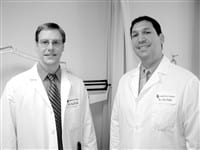CDH Ahead of Curve in Notifying Patients About Dense Breast Tissue
NORTHAMPTON — Some doctors say locating a breast abnormality in the midst of dense gland tissue can be like finding a polar bear in a snowstorm.
While dense breast tissue is common and not abnormal, it could increase the risk of cancer and make cancer detection more difficult. For this reason, the Mass. Department of Public Health now requires all mammography providers to give written notice to any patient whose mammogram shows dense breast tissue. DPH has given mammography providers until Jan. 1, 2015 to comply with the new law, but Cooley Dickinson’s new automated process that complies with it went live Sept. 24.
“We wanted to be ahead of the curve and work out any problems with implementation of this new law,” said Dr. Louis Pacilio, lead radiologist for mammography.
Added Deb Grandmont, women’s imaging supervisor, “overall, in women who have dense breasts, there is a higher incidence of missed breast cancer diagnoses. The purpose of this law is to inform and educate patients about dense breasts, explain what additional testing may be needed, and provide the patient with resources where she can learn more about breast density.”
It took six weeks for Pacilio, Grandmont, and Richard Papanos, RIS/PACS administrator, to develop an automated process that provides written notice to any patient whose mammogram shows dense breast tissue. Imagecast, the imaging computer system, includes a mammography module. In this module, the patient’s results are documented, as well as the breast-density rating. Based on the radiologist’s findings and the breast-density rating, a letter is generated and sent to the patient. This meets the requirements of the new DPH regulation.
“What took time was developing the new criteria, which are based on national standards, and adding those criteria to the module so the radiologist had these new options to choose from,” Papanos said. “From there, it was relying on our systems to automate the process.”
In the meantime, Pacilio added, nothing has been proven to improve survival in women with dense breasts other than mammography, and mammography is less sensitive in women with dense breasts. 3-D mammography has the promise to be helpful, as it is known to find more cancers at earlier stages than regular 2-D mammography alone, but the studies to prove decreased death rate are years away from being finalized.

